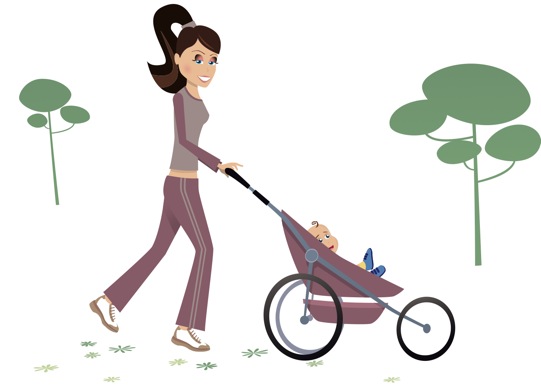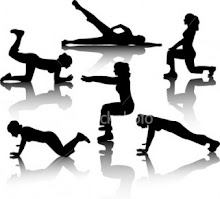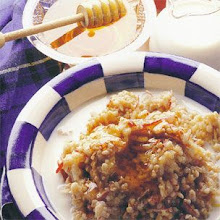
Tuesday, February 9, 2010
Healthy Recipes-Whole Wheat Oatmeal Chocolate Chip Cookies

Wednesday, February 3, 2010
Fitness Book Reviews-Abs Diet For Women

Monday, February 1, 2010
Workout Move of the Month-Squats and Lunges
Squats work multiple muscle groups -- the quadriceps, hamstrings, and gluteals -- at the same time.
How to: Keep your feet shoulder-width apart and your back straight. Bend your knees and lower your rear as if you were sitting down in a chair, keeping your knees over your ankles.
Like squats, lunges work all the major muscles of the lower body. Lunges also help improve your balance.
How to do it: Take a big step forward, keeping your spine straight. Bend your front knee to approximately 90 degrees. Keep weight on your back toes and drop the back knee toward the floor-- but don't let it touch the floor.
Start out just doing the exercises with no weights. A good rule of thumb is 3 sets of 10 for size and strength and 2 sets of 12-15 for toning. Once you feel comfortable try adding small weights like 3-5 lbs. As you get stronger you can increase your weights. Do this 2-3 times a week.
Sincerely,
The Fit Mamas
Saturday, January 30, 2010
Healthy Recipes- Garden Style Lasagna

GARDEN- STYLE LASAGNA
www.RecipeGirl.com
2 cups chopped onion
4 cloves garlic, minced
2 tsp olive oil, divided
2 cups chopped zucchini (about 8 ounces)
2 cups chopped yellow squash (about 8 ounces)
2 cups thinly sliced carrot (about 8 ounces)
2 cups chopped broccoli (about 6 ounces)
1 tsp salt, divided
½ cup flour
3½ cups 1% low-fat milk
1 cup (4 ounces) grated fresh Parmesan cheese, divided
¼ tsp freshly ground black pepper
dash of nutmeg
10 oz package frozen chopped spinach, thawed and squeezed dry
1½ cups 1% low-fat cottage cheese
2 cups (8 ounces) pre-shredded part-skim mozzarella cheese, divided
9 pre-cooked lasagna noodles, divided
1. Preheat oven to 375°F.
2. Heat a large Dutch oven over medium-high heat. Coat pan with cooking spray. Add onion to pan; sauté 4 minutes or until lightly browned. Add garlic; sauté 1 minute. Spoon onion mixture into a large bowl.
3. Heat 1 teaspoon oil in pan over medium-high heat. Add zucchini and yellow squash; sauté 4 minutes or until tender and just beginning to brown. Add to onion mixture.
4. Heat remaining 1 teaspoon oil in pan over medium-high heat. Add sliced carrot; sauté 4 minutes or until tender. Add chopped broccoli; sauté 4 minutes or until crisp-tender. Add to onion mixture. Sprinkle with ½ teaspoon salt; toss well to combine.
5. Place flour in a medium saucepan. Gradually add milk, stirring with a whisk until blended. Bring to a boil over medium heat; cook 2 minutes or until thick, stirring constantly. Remove from heat. Add ½ cup Parmesan, remaining ½ teaspoon salt, pepper, and nutmeg; stir until smooth. Stir in spinach.
6. Combine cottage cheese and 1½ cups mozzarella; stir well. Spread ½ cup spinach mixture in bottom of 13×9-inch baking dish coated with cooking spray. Arrange 3 noodles over spinach mixture in dish; top with half of cottage cheese mixture, then half of vegetable mixture, and about 1 cup spinach mixture. Repeat layers, ending with noodles. Spread remaining spinach mixture on top of noodles; sprinkle with remaining ½ cup Parmesan and remaining ½ cup mozzarella.
7. Cover and bake for 20 minutes. Uncover and bake an additional 20 minutes or until cheese is bubbly and beginning to brown. Let stand 10 minutes before serving.
Servings: 12
Nutrition Facts
Amount Per Serving
Calories 286
Calories From Fat (26%) 75
Total Fat 8.32g
Saturated Fat 4.52g
Cholesterol 26.10mgS
odium 704.12mg
Potassium 529.39mg
Carbohydrates 33.45g
Dietary Fiber 2.99g
Sugar 7.77g
Net Carbohydrates 30.46g
Protein 20.01g
WW POINTS: 7
Recipe Source: Adapted from Cooking Light
Sincerely,
Tuesday, January 26, 2010
The Benefits of Yoga

Flexibility
The series of yoga poses called asanas work by safely stretching your muscles. This releases the lactic acid that builds up with muscle use and causes stiffness, tension, pain, and fatigue. In addition, yoga increases the range of motion in joints. It may also increase lubrication in the joints. The outcome is a sense of ease and fluidity throughout your body.
Yoga stretches not only your muscles but all of the soft tissues of your body. That includes ligaments, tendons, and the fascia sheath that surrounds your muscles. And no matter your level of yoga, you most likely will see benefits in a very short period of time. In one study, participants had up to 35% improvement in flexibility after only eight weeks of yoga. The greatest gains were in shoulder and trunk flexibility.
Strength
Some styles of yoga, such as ashtanga and power yoga, are more vigorous than others. Practicing one of these styles will help you improve muscle tone.
But even less vigorous styles of yoga, such as Iyengar yoga, which focuses on less movement and more precise alignment in poses, can provide strength and endurance benefits.
Many of the poses, such as Downward Dog, Upward Dog, and Plank pose, build upper-body strength. This becomes crucial as people age. The standing poses, especially if you hold them for several long breaths, build strength in your hamstrings, quadriceps, and abdominal muscles. Poses that strengthen the lower back include Upward Dog and Chair pose. When practiced correctly, nearly all poses build core strength in the deep abdominal muscles.
Posture
With increased flexibility and strength comes better posture. Most standing and sitting poses develop core strength. That's because you're counting on your deep abdominals to support and maintain each pose. With a stronger core, you're more likely to sit and stand "tall." Another benefit of yoga is the increased body awareness. This heightened awareness tells you more quickly when you're slouching or slumping so you can adjust your posture.
Because of the deep, mindful breathing that yoga involves, lung capacity often improves. This in turn can improve sports performance and endurance. But yoga typically isn't focused on aerobic fitness the way running or cycling are. Taking an intense power yoga class that gets you breathing hard in a heated room, however, can provide an aerobic benefit.
Most forms of yoga emphasize deepening and lengthening your breath. This stimulates the relaxation response -- the opposite of the fight-or-flight adrenaline boost of the stress response.
Even beginners tend to feel less stressed and more relaxed after their first class. Some yoga styles use specific meditation techniques to quiet the constant "mind chatter" that often underlies stress. Other yoga styles depend on deep breathing techniques to focus your mind on the breath. When this happens, your mind becomes calm.
Among yoga's anti-stress benefits are a host of biochemical responses. For example, there is a decrease in catecholamines, the hormones produced by the adrenal glands in response to stress. Lowering levels of hormone neurotransmitters -- dopamine, norepinephrine, and epinephrine -- creates a feeling of calm. Some research points to a boost in the hormone oxytocin. This is the so-called "trust" and "bonding" hormone that's associated with feeling relaxed and connected to others. That may be why so many romances start in the yoga studio.
Harder to pin down and research scientifically, concentration and the ability to focus mentally are common benefits you'll hear yoga students talk about. The same is true with mood. Nearly every yoga student will tell you they feel happier and more contented after class. Recently, researchers have begun exploring the effects of yoga on depression , a benefit that may result from yoga's boosting oxygen levels to the brain. Yoga is even being studied as an adjunct therapy to relieve symptoms of obsessive-compulsive disorder.
Perhaps one of the most studied areas of the health benefits of yoga is its effect on heart disease. Yoga has long been known to lower blood pressure and slow the heart rate. A slower heart rate can benefit people with hypertension, heart disease, and stroke. Yoga was a key component to the heart disease program designed by Dean Ornish, MD. This was the first program to partly reverse heart disease through lifestyle and diet rather than surgery. On a biochemical level, studies point to a possible anti-oxidant effect of yoga. And yoga has been associated with decreased cholesterol and triglyceride levels as well as a boost in immune system function.
As yoga has become more popular in the West, medical researchers have begun studying the benefits of therapeutic yoga. This is also called integrative yoga therapy or IYT. It's used as an adjunct treatment for specific medical conditions, from clinical depression to heart disease. Yoga benefits other chronic medical conditions, relieving symptoms of asthma, back pain, and arthritis. Most worldwide clinical studies are happening outside of the United States. But even the NIH has funded clinical trials on yoga and its health benefits for insomnia and multiple sclerosis.
Friday, January 22, 2010
Fitness Book Review- Run Less Run Faster

The only caution I have through personal experience and experience of friends, not to devote all your energy (above what your body can handle) in too short of a time period for the training runs. This can deplete your body of stored energy and hinder muscle recovery, thus resulting in overtraining. By the time race day comes unfortunately you'll have used up all your body has to give and won't be able to perform your best. If you are going a lot faster than the prescribed times, maybe back off a little and gradually build up speed or better yet, save it for race day!
I would recommend this book to anyone from beginner to experienced runner. Whether you're just looking to mix up your workouts at the gym or want to take on a new fitness goal --like running a 1/2 or full marathon this book is bound to have some helpful information.
Sincerely,
The Fit Mamas
Wednesday, January 20, 2010
Exercise Equipment- Stability Ball

Select a ball based on your height:
Squat with a Ball
Yes, this is an awesome thigh and butt toner. Find a larger wall space than you think you'll need before hiking up the ball to the wall.
Do it:
Place an exercise ball between the wall and the curve of your lower back.
Stand with your feet shoulder-width apart.
Bend your knees and lower 5 to 10 inches, keeping your shoulders level and your hips square. Hold this position for 3 seconds and then stand back up.
Start with 5 reps and work up to 12. Rest for 30 seconds and do another set.
Smile. You're already one step closer to looking great in that swim suit!
Sincerely,
The Fit Mamas





